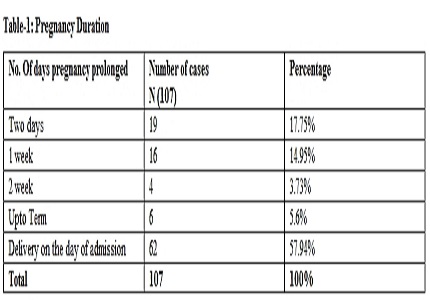A Prospective study of etiology and outcome of Preterm Labour in a Rural Medical College
Abstract
Introduction: Preterm birth is a major problem in developing countries contributing significantly to perinatal mortality. Preventing preterm labor is still a great challenge in modern obstetrics. Every year an estimated 15 million babies are born too early (more than 1 in 10 babies are preterm). 1 million neonates dies each year due to complication of preterm birth. Many who survive face a life time of disability.
Aim & Objective: To study the etiological factors and to assess the Neonatal Mortality and Morbidity associated with preterm labor and delivery.
Methods: This prospective study was conducted from December 2014 to September 2015 in rural medical college where 107 antenatal women admitted with threatened preterm labor with or without rupture of membranes were followed till delivery and discharge. Gestational age at onset of preterm labor, associated risk factors, response to Tocolytics, Gestational age at delivery, and neonatal outcome were recorded and analysed.
Results: Pregnancy Induced Hypertension, Anaemia, Infections, Oligohydramnios, were the commonest causes of preterm deliveries. Neonatal morbidity and mortality was less in steroid covered group. Birth asphyxia, Respiratory Distress Syndrome, Hyaline Membrane Disease were the commonest causes of morbidity. Respiratory Distress Syndrome was significantly reduced in those who were on steroid cover.
Conclusion: There is a high incidence of preterm labor and preterm births in our set up. Infection and anaemia are important factors which can be prevented. Prolongation of delivery for 48 hrs by giving Tocolysis for getting the benefit of betamethasone coverage reduces morbidity due to RDS.
Downloads
References
2. Fact sheet N 363, WHO Media centre ( www WHO, Int/ media centre/factsheet/fs363)
3. Sayres WG Jr. Preterm labor. Am Fam Physician. 2010 Feb 15;81(4):477-84. [PubMed]
4. Harry M Georgiou, Megan .K.W.Di Quinzio ,Michael permezel ,Shaun .P Brennecke; Predecting Preterm Labor : Current status and future prospects; Disease Markers;dx doi.org/10.1155/2015/435014.
5. Martin JA, Kochanek KD, Strobino DM, Guyer B, MacDorman MF. Annual summary of vital statistics--2003. Pediatrics. 2005 Mar;115(3):619-34. [PubMed]
6. Roberts CL, Algert CS, Carnegie M, Peat B. Operative delivery during labour: trends and predictive factors. Paediatr Perinat Epidemiol. 2002 Apr;16(2):115-23. [PubMed]
7. American College of Obstetricians and Gynecologists; Committee on Practice Bulletins—Obstetrics. ACOG practice bulletin no. 127: Management of preterm labor. Obstet Gynecol. 2012 Jun;119(6):1308-17. doi: 10.1097/AOG.0b013e31825af2f0.
8. McPheeters ML, Miller WC, Hartmann KE, Savitz DA, Kaufman JS, Garrett JM, Thorp JM. The epidemiology of threatened preterm labor: a prospective cohort study. Am J Obstet Gynecol. 2005 Apr;192(4):1325-9; discussion 1329-30.
9. Gonçalves LF, Chaiworapongsa T, Romero R. Intrauterine infection and prematurity. Ment Retard Dev Disabil Res Rev. 2002;8(1):3-13. [PubMed]
10. Lamont RF. Infection in the prediction and antibiotics in the prevention of spontaneous preterm labour and preterm birth. BJOG. 2003 Apr;110 Suppl 20:71-5.
11. Wright SP, Mitchell EA, Thompson JM, Clements MS, Ford RP, Stewart AW. Risk factors for preterm birth: a New Zealand study. N Z Med J. 1998 Jan 23;111(1058):14-6. [PubMed]
12. Scholl TO, Hediger ML. Anemia and iron-deficiency anemia: compilation of data on pregnancy outcome. Am J Clin Nutr. 1994 Feb;59(2 Suppl):492S-500S discussion 500S-501S. [PubMed]
13. Samadi AR, Mayberry RM. Maternal hypertension and spontaneous preterm births among black women. Obstet Gynecol. 1998 Jun;91(6):899-904.
14. Juliar Warner Gargon ,Claudia B Holzman,Patricia K .Senagore, M. Lynne Reuss; Evidence of placental haemorrhage and preterm delivery, British Journal of Obstetrics and gynaecology;2010 March 117(4):445-455.
15. C. Holzman, B. Bullen, R. Fisher, N. Paneth, L. Reuss, Prematurity Study Group Pregnancy outcomes and community health: the POUCH study of preterm birth, DOI: 10.1046/j.1365-3016.2001.00014.x
16. Singh Uma, Singh Nisha, Seth Shikha. A prospective analysis of etiology and outcome of preterm labour. J Obstet Gynecol India. 2007;57(1):48-52.
17. Adewole IF .Prophylactic antibiotics for inhibiting preterm labour with intact membranes: RHL commentary (last revised: 15 November2002). The WHO Reproductive health library; Geneva: World Health Organisation.
18. C. Hubinont and F. Debieve. Review Article, Prevention of preterm labour: 2011 Update on Tocolysis ,Journal of pregnancy, volume 2011, Article ID 941057, 5. [PubMed]

Copyright (c) 2016 Author (s). Published by Siddharth Health Research and Social Welfare Society

This work is licensed under a Creative Commons Attribution 4.0 International License.


 OAI - Open Archives Initiative
OAI - Open Archives Initiative



















 Therapoid
Therapoid

